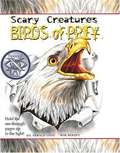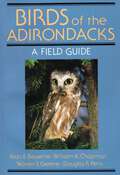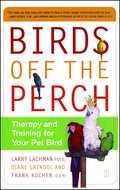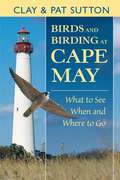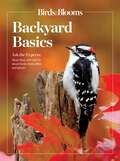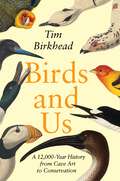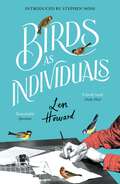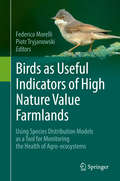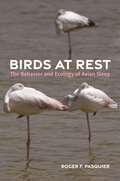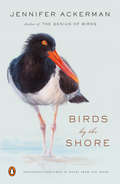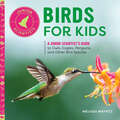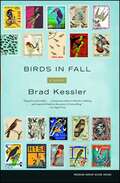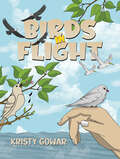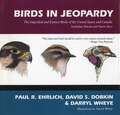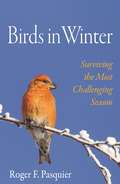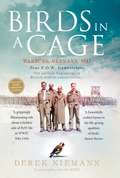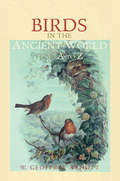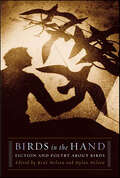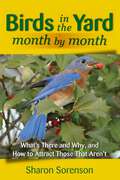- Table View
- List View
Birds Of Prey (Scary Creatures)
by Gerald Legg Bob HerseyDescribes the appearance and behavior of owls, eagles, vultures, and other birds of prey and examines why they are frightening.
Birds Of The Adirondacks: A Field Guide
by William K. Chapman Alan BessetteThis latest addition to the North Country Books field guide series will be welcomed by avid fans of the Adirondacks. Descriptions of over 200 species of birds highlight the informative text. For ease of identification the birds are categorized into the eight basic groups. Special sections of feeding, attracting and photographing are included. There is also a checklist and room for field notes.
Birds Off the Perch
by Larry Lachman Diane Grindol Frank KocherYou love your pet bird, even when he misbehaves, but how can you train him with compassion? Birds off the Perch proves that rewarding good behavior is kinder and more effective than traditional discipline through punishment. This revolutionary approach combines the expertise of an animal behaviorist, a companion parrot consultant and a veterinarian who use "family therapy techniques" -- such as learning to respect the bird's boundaries and viewing sibling rivalry in a broad, environmental context -- to help you change the mischievous behavior of domesticated birds, including: Biting or aggression Screaming Sibling/bird rivalry Jealousy toward its human flock members, and Feather plucking With additional chapters on choosing the right species for your family, breeding behavior and the appropriate medical care for your bird, Birds off the Perch is the only guide you'll need to keep your pet birds healthy and happy.
Birds and Bees, Sharp Eyes and Other Papers
by John BurroughsFrom the Biographical Sketch:<P> "Probably no other American writer has a greater sympathy with, and a keener enjoyment of, country life in all its phases--farming, camping, fishing, walking--than has John Burroughs. His books are redolent of the soil, and have such "freshness and primal sweetness," that we need not be told that the pleasure he gets from his walks and excursions is by no means over when he steps inside his doors again. As he tells us on more than one occasion, he finds he can get much more out of his outdoor experiences by thinking them over, and writing them out afterwards."<P> Mary E. Burt
Birds and Birding at Cape May
by Clay Sutton Pat SuttonFirst-ever birding guide to this celebrated site. Insider advice on 33 popular places and lesser-known hot spots. Describes birding opportunities any time of the year.
Birds and Blooms Backyard Basics
by Birds And BloomsA Simon & Schuster eBook. Simon & Schuster has a great book for every reader.
Birds and Climate Change
by James W. Pearce-Higgins Rhys E. GreenFrom the red grouse to the Ethiopian bush-crow, bird populations around the world can provide us with vital insights into the effects of climate change on species and ecosystems. They are among the best studied and monitored of organisms, yet many are already under threat of extinction as a result of habitat loss, overexploitation and pollution. Providing a single source of information for students, scientists, practitioners and policy-makers, this book begins with a critical review of the existing impacts of climate change on birds, including changes in the timing of migration and breeding and effects on bird populations around the world. The second part considers how conservationists can assess potential future impacts, quantifying how extinction risk is linked to the magnitude of global change and synthesising the evidence in support of likely conservation responses. The final chapters assess the threats posed by efforts to reduce the magnitude of climate change.
Birds and Habitat
by Robert J. FullerThe successful conservation of bird species relies upon our understanding of their habitat use and requirements. In the coming decades the importance of such knowledge will only grow as climate change, the development of new energy sources and the needs of a growing human population intensify the, already significant, pressure on the habitats that birds depend on. Drawing on valuable recent advances in our understanding of bird-habitat relationships, this book provides the first major review of avian habitat selection in over twenty years. It offers a synthesis of concepts, patterns and issues that will interest students, researchers and conservation practitioners. Spatial scales ranging from landscape to habitat patch are covered, and examples of responses to habitat change are examined. European landscapes are the main focus, but the book has far wider significance to similar habitats worldwide, with examples and relevant material also drawn from North America and Australia.
Birds and Us: A 12,000-Year History from Cave Art to Conservation
by Tim BirkheadFrom award-winning author and ornithologist Tim Birkhead, a sweeping history of the long and close relationship between birds and humansSince the dawn of human history, birds have stirred our imagination, inspiring and challenging our ideas about science, faith, art, and philosophy. We have worshipped birds as gods, hunted them for sustenance, adorned ourselves with their feathers, studied their wings to engineer flight, and, more recently, attempted to protect them. In Birds and Us, award-winning writer and ornithologist Tim Birkhead takes us on a dazzling epic journey through our mutual history with birds, from the ibises mummified and deified by Ancient Egyptians to the Renaissance fascination with woodpecker anatomy—and from the Victorian obsession with egg collecting to today’s fight to save endangered species and restore their habitats.Spanning continents and millennia, Birds and Us chronicles the beginnings of a written history of birds in ancient Greece and Rome, the obsession with falconry in the Middle Ages, and the development of ornithological science. Moving to the twentieth century, the book tells the story of the emergence of birdwatching and the field study of birds, and how they triggered an extraordinary flowering of knowledge and empathy for birds, eventually leading to today’s massive worldwide interest in birds—and the realization of the urgent need to save them.Weaving in stories from Birkhead’s life as scientist, including far-flung expeditions to wondrous Neolithic caves in Spain and the bustling guillemot colonies of the Faroe Islands, this rich and fascinating book is an unforgettable account of how birds have shaped us, and how we have shaped them.
Birds as Individuals
by Len HowardEnter the secret lives of Britain's ordinary garden birds and the brilliant, unconventional woman who opened her doors to them.In the late 1930s, Len Howard packed up her life in London, bought a plot of land in Sussex and built herself a little house there. This was to be Bird Cottage, a place where the doors of the house were open to the birds of the garden – great tits, blue tits, robins, blackbirds, willow warblers and many others. Len lived the rest of her life alongside her bird neighbours, with some sleeping in her bedroom and many flitting in and out all day long.This is the book she wrote about the birds – a study not just of their behaviour but their individual personalities. We learn about their intelligence, emotional lives, and characters, their capacity for play and humour, the range of their song, their likes and dislikes, and their bond with Len.Enchanting, life-enriching, revelatory and completely original, this is a gorgeous evocation of a life lived in intimate contact with nature and a book about birds unlike any other.‘A unique, engaging and elegant insight into the lives of our precious and magical songbirds’ Arthur Parkinson‘A quiet revelation of attentiveness and sympathy. It impressed and moved me very much’ Steven Lovatt, author of Birdsong in a Time of Silence
Birds as Useful Indicators of High Nature Value Farmlands: Using Species Distribution Models as a Tool for Monitoring the Health of Agro-ecosystems
by Federico Morelli Piotr TryjanowskiThis book helps to establish a simple framework to identify and use bird species as a bioindicator for high nature value (HNV) farmlands. This book focuses on suitable methods for monitoring the HNV areas, and presents the results of several case studies. The chapters put forward ways to integrate ecosystems assessment, geographical information systems (GIS) and strategies for conservation of local biodiversity. An innovative framework focuses on the use of species distribution models (SDMs) in order to explore the importance of each characteristic of HNV farmlands. Furthermore, the book examines the relationships among bird species richness, land use diversity and landscape metrics at a local scale in the farmlands.
Birds at Home
by Marguerite HenryIn this narrative book, the author describes the lives of 22 common birds.
Birds at Rest: The Behavior and Ecology of Avian Sleep
by Roger PasquierA wide-ranging account of how birds spend the quiet half of their livesBirds at Rest is the first book to give a full picture of how birds rest, roost, and sleep, a vital part of their lives. It features new science that can measure what is happening in a bird&’s brain over the course of a night or when it has flown to another hemisphere, as well as still-valuable observations by legendary naturalists such as John James Audubon, Alfred Russel Wallace, and Theodore Roosevelt. Much of what they saw and what ornithologists are studying today can be observed and enjoyed by any birder.From the poles to the tropics, how, when, and where birds sleep reflect the ecology and behavior of each species, as well as their evolution from dinosaur ancestors. Some sleep briefly, their brain half awake, others spend long cold nights in torpor, and a few can sleep while flying. Their roosting habits are also varied. Most birds sleep alone, some in pairs or families, while others in flocks of millions. Birds at Rest explains how each strategy works over the course of a season, a year, or a lifetime by providing protection, mating opportunities, information about food, and other survival benefits.With evocative drawings by artist and illustrator Margaret La Farge, Birds at Rest discusses how environmental challenges such as artificial lights and noise, invasive species, and climate change are disrupting avian sleep and proposes solutions to ensure that birds get the rest they need.
Birds by the Shore: Observing the Natural Life of the Atlantic Coast
by Jennifer AckermanFrom the bestselling author of The Genius of Birds, the revised and reissued edition of her beloved book of essays describing her forays along the Delaware shoreFor three years, Jennifer Ackerman lived in the small coastal town of Lewes, Delaware, in the sort of blue-water, white-sand landscape that draws summer crowds up and down the eastern seaboard. Birds by the Shore is a book about discovering the natural life at the ocean's edge: the habits of shorebirds and seabirds, the movement of sand and water, the wealth of creatures that survive amid storm and surf. Against this landscape's rhythms, Ackerman revisits her own history--her mother's death, her father's illness and her hopes to have children of her own.This portrait of life at the ocean's edge will be relished by anyone who has walked a beach at sunset, or watched a hawk hover over a winter marsh, and felt part of the natural world. With a quiet passion and friendly, generous intelligence, it explores the way that landscape shapes our thoughts and perceptions and shows that home ground is often where we feel the deepest response to the planet.
Birds for Kids: A Junior Scientist's Guide to Owls, Eagles, Penguins, and Other Bird Species (Junior Scientists)
by Melissa MayntzExplore the wild and wonderful world of birds with the Junior Scientists series for kids ages 6 to 9From tiny hummingbirds to powerful eagles and everything in between—our planet is home to so many beautifully feathered friends! This big book of birds is packed with tons of cool facts and colorful photos that offer a fascinating peek into their lives. It's written especially for curious new readers, with engaging trivia and age-appropriate language that lets kids read and explore independently as they learn all about birds!35 birds to meet— Kids will discover a variety of bird species like flamingos, penguins, and barn swallows, and find out what they look like, where they live, what they eat, and more.Fun facts—Keep young readers fascinated with cool facts about how baby birds are born, if birds can get lost when they fly, and which water bird eats baby alligators!Learning in action— You'll even find some activities to try, like helping your child measure their own wingspan, build a nest, and spotting your backyard birds.Get ready for an exciting journey through the lives of our beaked buddies in this ultimate bird book for kids.
Birds in Fall: A Novel
by Brad KesslerOne fall night off the coast of a remote island in Nova Scotia, an airplane plummets to the sea as an innkeeper watches from the shore. Miles away in New York City, ornithologist Ana Gathreaux works in a darkened room full of sparrows, testing their migratory instincts. Soon, Ana will be bound for Trachis Island, along with other relatives of victims who converge on the site of the tragedy. As the search for survivors envelops the island, the mourning families gather at the inn, waiting for news of those they have lost. Here among strangers, and watched over by innkeeper Kevin Gearns, they form an unusual community, struggling for comfort and consolation. A Taiwanese couple sets out fruit for their daughter's ghost. A Bulgarian man plays piano in the dark, sending the music to his lost wife, a cellist. Two Dutch teenagers, a brother and sister, rage against their parents' death. An Iranian exile, mourning his niece, recites the Persian tales that carry the wisdom of centuries. At the center of Birds in Fall lies Ana Gathreaux, whose story Brad Kessler tells with deep compassion: from her days in the field with her husband, observing and banding migratory birds, to her enduring grief and gradual reengagement with life. Kessler's knowledge of the natural world, music, and myth enriches every page of this hauntingly beautiful and moving novel about solitude, love, losing your way, and finding something like home.
Birds in Flight
by Kristy GowarWhere do the birds go to on their flight? Out over the sea with no land in sight? Or high above clouds to feel the sunlight? How do they find their way home for the night? Birds in Flight has a simple rhyming scheme, to assist with learning to read and beginning to spell. With a combination of beautiful illustrations and an easy flowing story, This book is also a perfect bedtime read.
Birds in Jeopardy: The Imperiled and Extinct Birds of the United States and Canada
by Paul R. Ehrlich David S. Dobkin Darryl WheyeAs the human population skyrockets and the toxic impact of human society spreads, the natural habitats of birds degrade and diminish and the bird populations decline. Two hundred years ago, when the United States and Canada were home to less than 5 million people, they were also home to some 650 species of birds. Today, more than 280 million people live there, and 33 bird species have already been driven to extinction and well over 150 are in danger of extinction in all. Or parts of their range. This book, organized and written by the authors of The Birder's Handbook, and enriched by 191 strikingly beautiful color paintings illustrating all of the birds treated, is the first concise, authoritative review of the status of the birds currently imperiled in the United States and Canada - those that are federally listed as Endangered or Threatened and those that are listed by the National Audubon Society as suffering local or regional or. Widespread decline. It also treats the birds that have been driven to extinction in the past two centuries, since the stories of their somber fates can help us learn how to save the other birds that are in jeopardy. Because birdwatchers and others are showing increased interest in the tropical birds that survive in Hawaii and Puerto Rico, the book includes separate sections on the imperiled and extinct birds of those areas. Hawaii is of special importance: because it has. Seen so many extinctions just in the years since Cook's arrival (23 species and subspecies), it provides a laboratory for studying the impact of civilization on birds in the wild. The individual texts - written in clear, non-technical language - cover requirements for successful nesting and feeding; worldwide and North American breeding range, wintering range, and imperiled portions of range; current population estimates (for Threatened and Endangered birds); behavioral. And other factors pertinent to conservation; former and/or current threats associated with decline; current status of imperilment; federally funded recovery plans; and the date of last sighting, in those desperate cases where extinction is imminent or already a fact. In the last century, coal miners took canaries into the mines, reasoning that if poisonous gases were present, the birds would give warning by succumbing first. Now birds are serving as miners' canaries once. Again. In the language of ecology, they are good indicator species, warning us that too many people, unbridled consumption of wildlands and other natural resources, faulty technologies, and irresponsible disposal of chemical and other wastes threaten not just birds but ourselves and every other living thing. In our daily lives we seldom see the terrible effects of these forces but they are demonstrated every day by scientific surveys of the environment, around the world.
Birds in Winter: Surviving the Most Challenging Season
by Roger F. PasquierHow birds have evolved and adapted to survive winterBirds in Winter is the first book devoted to the ecology and behavior of birds during this most challenging season. Birds remaining in regions with cold weather must cope with much shorter days to find food and shelter even as they need to avoid predators and stay warm through the long nights, while migrants to the tropics must fit into very different ecosystems and communities of resident birds. Roger Pasquier explores how winter affects birds’ lives all through the year, starting in late summer, when some begin caching food to retrieve months later and others form social groups lasting into the next spring. During winter some birds are already pairing up for the following breeding season, so health through the winter contributes to nesting success.Today, rapidly advancing technologies are enabling scientists to track individual birds through their daily and annual movements at home and across oceans and hemispheres, revealing new and unexpected information about their lives and interactions. But, as Birds in Winter shows, much is visible to any interested observer. Pasquier describes the season’s distinct conservation challenges for birds that winter where they have bred and for migrants to distant regions. Finally, global warming is altering the nature of winter itself. Whether birds that have evolved over millennia to survive this season can now adjust to a rapidly changing climate is a problem all people who enjoy watching them must consider.Filled with elegant line drawings by artist and illustrator Margaret La Farge, Birds in Winter describes how winter influences the lives of birds from the poles to the equator.
Birds in a Cage: Warburg, Germany, 1941- Four P. O. W. Birdwatchers - The Unlikely Beginning Of British Wildlife Conservation...
by Derek NiemannThis is the inspiring true story of how a passion for birds enabled four young men to escape the horror of internment in a German PoW camp... and brought about an extraordinary moment of cooperation and mutual understanding between them and their captors. Soon after their incarceration at Warburg in 1941, Peter Conder, John Buxton, John Barrett and George Waterston discovered a shared love of birdwatching. Before long, their obsessive quest for information on the nesting habits of chaffinches, redstarts and others took over the whole camp - including some of the German guards, who began to assist the PoWs in their observations at great risk to their own lives. In this tender, revelatory book, Derek Niemann draws on original diaries, letters and drawings, as well as the memories of those...
Birds in the Ancient World from A to Z (The Ancient World from A to Z)
by W. Geoffrey ArnottBirds in the Ancient World from A to Z gathers together the ancient information available, listing all the names that ancient Greeks gave their birds and all their descriptions and analyses. W. Geoffrey Arnott identifies as many of them as possible in the light of modern ornithological studies. The ancient Greek bird names are transliterated into English script, and all that the ancients said about birds is presented in English. This book is accordingly the first complete discussion of ancient bird names that will be accessible to readers without ancient Greek. The only large-scale examination of ancient birds for seventy years, the book has an exhaustive bibliography (partly classical scholarship and partly ornithological) to encourage further study, and provides students and ornithologists with the definitive study of ancient birds.
Birds in the City (Fountas & Pinnell Classroom, Guided Reading)
by Susan BuckleyNIMAC-sourced textbook
Birds in the Hand: Fiction and Poetry About Birds
by Dylan NelsonA unique anthology of avian literatureFrom the myths of ancient Greece to the fables of Aesop, from Chaucer to contemporary poetry and fiction, birds are central to literature because they connect us intimately to the natural world. Whether we watch birds at our feeders, travel vast distances to identify rare species, or simply pause in a busy day to listen to the coo of a dove or the trill of a warbler, birds sustain us.Birds in the Hand is a collection of contemporary fiction and poetry that explores the complex, often startling ways in which birds shed light upon our lives. In work from a diverse and celebrated group of contemporary authors such as Charles Baxter, T.C. Boyle, Jim Harrison, Flannery O'Connor, Pattiann Rogers, Seamus Heaney, Derek Walcott, Ethan Canin, and Jorie Graham, birds are sources of inspiration, confrontation, and revelation.These stories and poems take us from New York and Hoboken to the Salton Sea and the wilds of Montana, from a hardware store to the westernmost Aleutian island, from a prison to marshes, forests, and seacoasts.Field guides and natural history books cannot capture the essence of why birds thrill us. Birds in the Hand uses the vitality and nuance of fiction and poetry to get at the heart of our mysterious sense of birds and the way they can reflect the brightest and darkest aspects of our own natures.
Birds in the Wilderness: Adventures of an Ornithologist
by George Miksch SuttonTrained as an ornithologist and painter, George M. Sutton recounts a series of adventures with birds in the first decades of the twentieth century. In "Titania and Oberon" he tells the story of raising a pair of baby road-runners. In "The Harris's Sparrow's Eggs" he describes the fierce competition between U.S. and Canadian ornithologists who searched for the nest and eggs of a reclusive bird. In "Kints!" Sutton writes of observing and recording one of the last known nesting pairs of ivory-billed woodpeckers.
Birds in the Yard Month by Month
by Sharon SorensonGet to know all the birds that will flock to your yard throughout the year, and how to attract those that need a little extra persuasion to visit.
